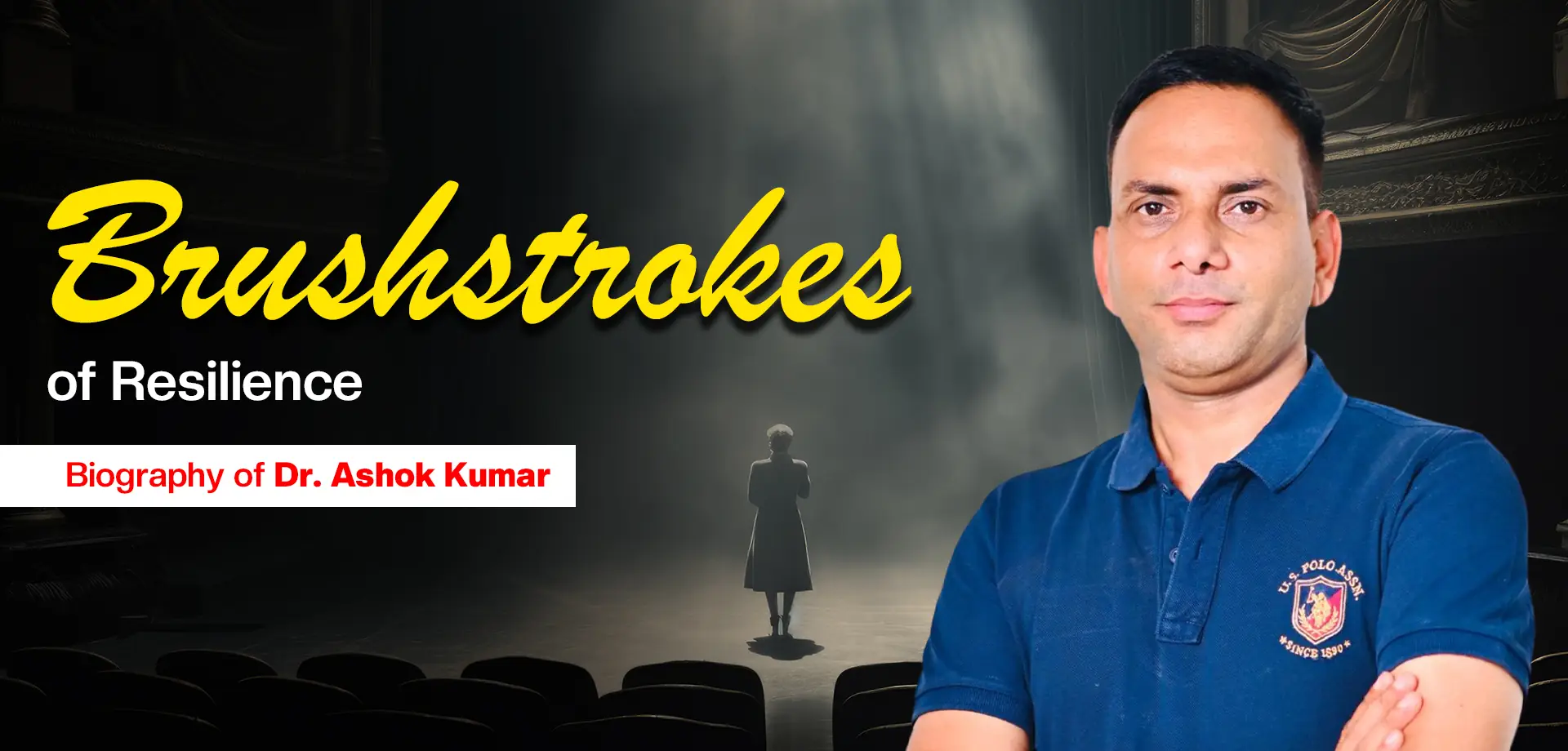
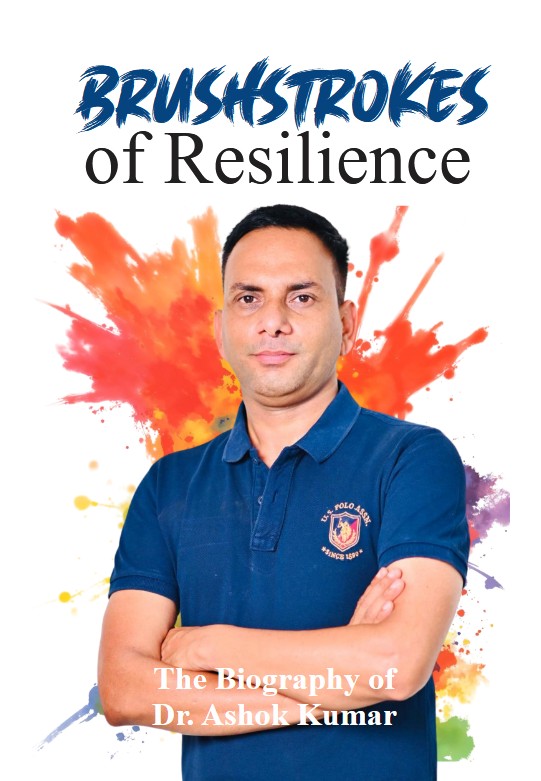
"Every artist dips his brush in his own soul, and paints his own nature into his pictures."
Introduction
A portrait of courage, drawn with patience, tenacity, and unflinching faith, this biography of Dr. Ashok Kumar is not simply a chronicle of dates, milestones, or achievements; rather, it is a portrait of courage. The trip that Dr. Ashok took from a little town in Uttar Pradesh to the vast halls of international renown is remarkable in both its humility and its inspiration. He was brought up in a humble family atmosphere, and it was not via formal education that he discovered his passion for art; rather, it was through a profound inner calling and an unquenchable urge to create. This biography is intended to preserve and present the unedited, raw reality of a person who chose the unusual path and walked it with pride. The objective of this book is to preserve and present the truth. This narrative is just as much about the fight as it is about the triumph. It ranges from mental anguish to financial difficulty, and it takes place on stages ranging from small local stages to global galleries.
In these pages, readers will discover a demonstration of the transformational power of belief, as well as a reminder that even the most unassuming beginnings may lead to the most astonishing destinies. The purpose of this biography is to pay tribute not just to Dr. Ashok’s artistic creations but also to the soul that gives them life.
The journey is about to start.
Phase 1 : Early Childhood and Education The Colors of a Humble Beginning
"It is not in the stars to hold our destiny but in ourselves.”
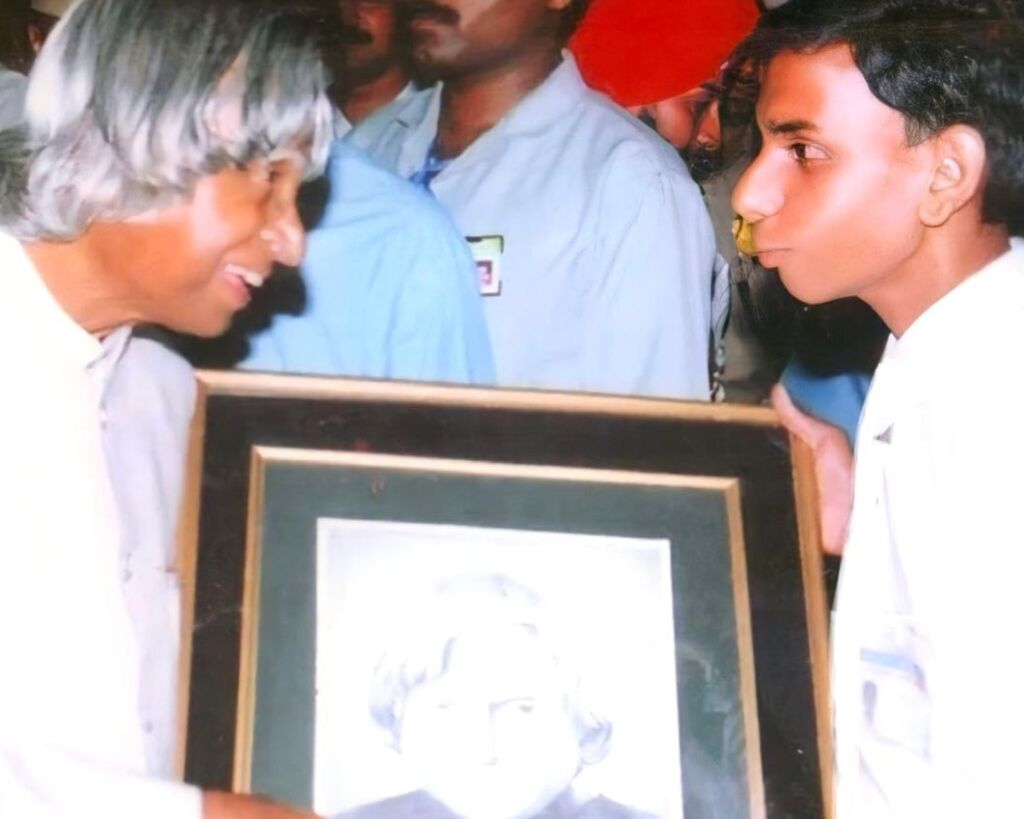
Dr. Ashok Kumar’s story begins in the heartlands of Uttar Pradesh, where he was born into a humble family. Though his birthplace was in UP, his heart and identity were shaped in Ludhiana, Punjab, where his father had migrated for work. The city’s narrow lanes and vibrant cultural textures became the canvas of his early life. Yet, despite the energy around him, Dr. Ashok’s childhood was marked more by struggle than by celebration.
Born in Ludhiana on September 5, 1985, he appeared to be destined for a life fated by creativity, even though life challenged him time and time again with unrelenting suffering. While his mother devoted herself totally to raising the family with warmth, care, and quiet strength, his father, Mr. Giri, worked relentlessly in the private sector to make ends meet. His mother, in turn, raised the family with quiet strength. Even though they made every effort, they were always confronted with financial difficulties, which frequently transformed even the most basic of ambitions into far-off luxury.
His father worked long hours in a private factory, earning a minimal wage to support his wife and three children. The nature of his father’s job meant Dr. Ashok often didn’t see him for days at a stretch. By the time Dr. Ashok woke up, his father had left for work, and by the time he returned, Dr. Ashok was asleep. This absence created a silent but powerful emotional void—one that Dr. Ashok filled with imagination, curiosity, and a surprising fondness for color.
A natural and profound inclination towards art was something that he displayed from a very young age onwards. As his classmates were engrossed in their schoolbooks, he found himself drawn to the pencils and sketchpads that were available to him. His hands moved in an instinctual manner, transforming blank sheets into vivid artistic manifestations of his feelings and ideas.
His art was not a pastime; rather, it was his language, his shelter, and his reason for living. He showed early signs of being deeply visual and emotionally sensitive. His school life, academically speaking, was unremarkable. Studies were not his strength, and textbooks didn’t hold his attention. But the art period was sacred. It was the only class where he truly felt seen and valued. One of his teachers, recognizing his innate ability, once told him, “If marks could go beyond 100, I would give them to you.” That single sentence became a lifelong affirmation for a boy who was otherwise struggling to find identity.
Dr. Ashok’s first significant breakthrough came in school during Diwali. While most students were preparing decorations and participating in routine activities, Dr. Ashok decided to create a hand-drawn portrait of Goddess Lakshmi and Lord Ganesha for the classroom. He poured himself into the work, combining faith with artistic fervor. The result wasn’t just a painting—it was a celebration of devotion, emotion, and color. His classmates applauded, his teacher was overwhelmed, and their class won first place in the school contest. For Dr. Ashok, this was not just a victory in a competition—it was a turning point. For the first time, he saw how his art could move people.
Phase 2 : Career and Achievements From Silent Sketches to Standing Ovations
“Success is no accident. It is hard work, perseverance, learning, studying, sacrifice, and most of all, love of what you are doing.”
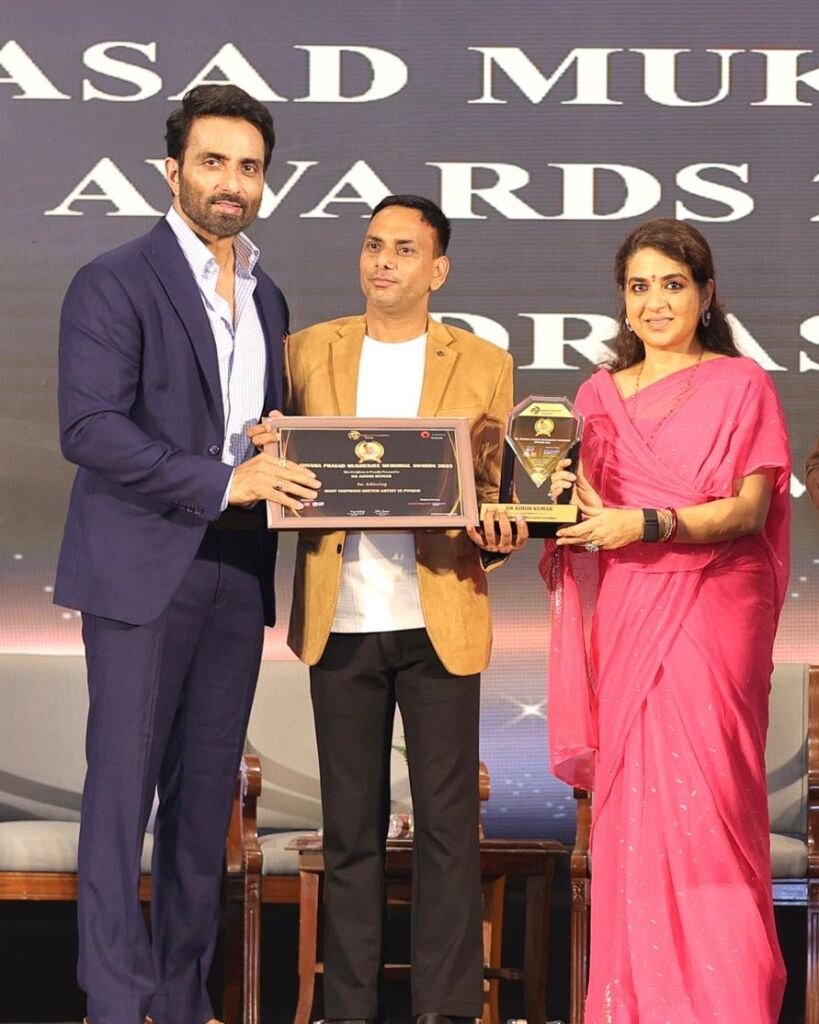
Dr. Ashok Kumar’s career is a testament to the power of passion pursued against all odds. With no formal art education, no professional network, and limited financial resources, he turned his humble beginnings into the foundation of a career that would one day capture international attention.
In the eyes of Dr. Ashok Kumar, he has never been defined by celebrity, fortune, or applause; rather, it has been characterized by the silent fulfilment of promises that were not expressed. It was not in an art gallery or at an award ceremony that he experienced one of the most emotionally moving moments of his journey; rather, it was the simple act of watching his father sit in a luxury car that was exactly his car.
In the past, he had presented his father with a bicycle. After that, an automobile. On the other hand, the actual reward was an emotional one: the pride that could be seen on his father’s face as he sat in a car that his son had earned by sheer willpower and unmatched determination. In response to Dr. Ashok’s request for his father to select a luxury car, the father responded in a humble manner, “Are you capable of handling this?” “Even if I drown in debt, Papa, I’ll make it happen for you,” Ashok responded with tears of determination in his eyes.
Nevertheless, fate had its bounds. In 2024, his father passed suddenly, having only had the opportunity to enjoy that privilege a few times, which amounted to four or five rides, memories that are now permanently imprinted in Ashok’s heart.
He says it in a low voice, “I miss him,” although the pain is intense. It’s not just sadness; it’s love caught in the middle of a sentence. A father and a son had both worked tirelessly, with one working in silence and the other working in colour. Their efforts resulted in a legacy of perseverance that they both shared.
A defining milestone in his career came when he created a portrait of a local political figure, Simranjit Singh Banis. The recognition he received and the ₹500 reward, might seem modest on the surface, but they ignited a deeper belief in his purpose. It was the first time he realized that art could earn not just admiration, but livelihood and respect.
Over the years, Dr. Ashok began working with newer forms and techniques, constantly pushing the boundaries of his creativity. From intricate pencil sketches to elaborate oil paintings and American diamond-studded artworks, his portfolio grew as dynamically as his confidence. What set him apart was not just his command over various media, but his insistence on emotional storytelling in every piece. Each portrait carried an essence—a life captured in expression and detail.
Phase 3 : Professional Milestones and Achievements A Trail of Triumphs
"Every artist was first an amateur.”
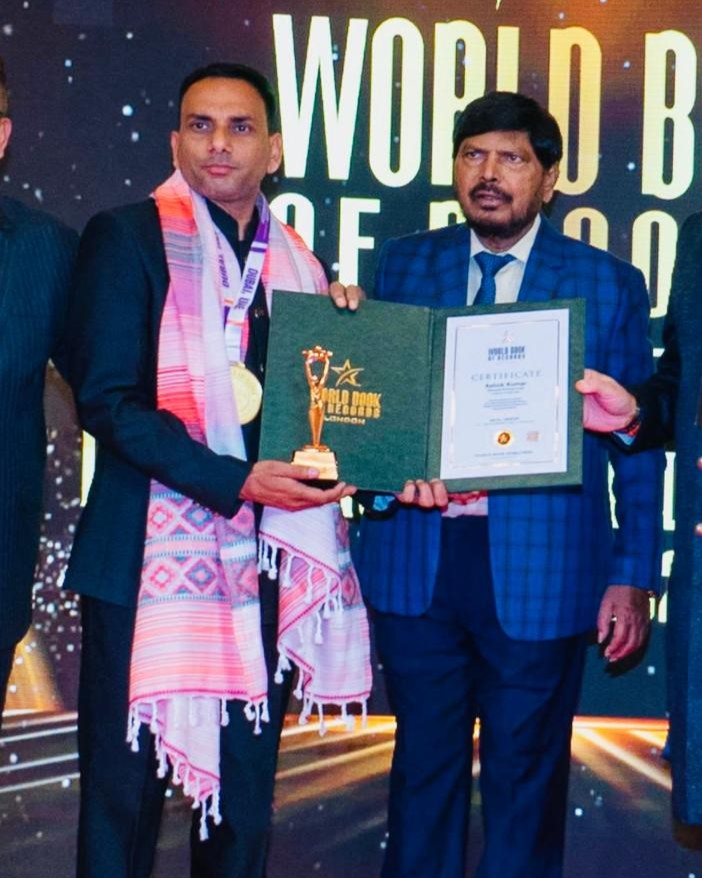
Dr. Ashok Kumar’s milestones are not merely artistic accolades; they are living symbols of perseverance, proving that greatness does not require perfect circumstances—only unwavering belief.
Dr. Ashok Kumar’s professional trajectory stands as a testament to what determination and raw passion can achieve in the face of adversity. With no academic degree in fine arts or access to established art institutions, Dr. Ashok built his reputation and career from the ground up, one canvas at a time. His milestones, earned through persistence and authenticity, reflect not just personal growth but a larger narrative of artistic empowerment and cultural impact.
His family moved to Chandigarh since his father had a job in the private sector, and it was around this time that a significant turning point in his artistic career began to take shape. The long-standing admiration that he had for Dr. A.P.J. Abdul Kalam was strengthened by the fact that he was in this city, which was surrounded by new chances and challenges. He frequently read about the life, wisdom, and scientific contributions of the previous President, and he found that he was a strong source of inspiration. One day, the desire to meet Dr. Kalam became a goal that was not only silent but also unwavering.
In the course of his time spent in Chandigarh, he poured his admiration onto canvas, painting a portrait of Dr. Kalam that was both detailed and passionate. He did this in the hope that, against the odds, it would somehow reach the individual who had had such a significant impact on his personality. In the year 2009, fate took action. One of the Deputy Commissioners (DC) came across his artwork and was profoundly impacted by it.
Not only was he impressed by the accuracy of the likeness, but he was also impressed by the young artist’s determination in the face of challenges. Dr. Kalam received a letter of reference from the District of Columbia, which highlighted both his remarkable artistic gift and his life of suffering. The letter was written in recognition of both his talent and his circumstances.
Indeed, the unthinkable took place, much to his utter surprise. He was given the chance to meet Dr. A.P.J. Abdul Kalam in person, which was a moment that would forever alter the course that his life would take from that point on. The interaction, which was brief yet strong, acted as a turning point in the story.